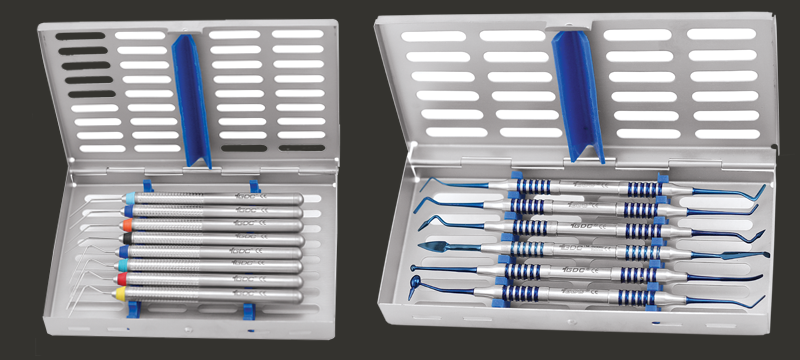
Table of Contents
Get Dental Catalogue PDF On Your Email
Best Practices for Organizing and Sterilizing Your Endodontic Kit
Organizing and sterilizing your endodontic instruments is more than just a routine—it directly impacts patient safety, clinical efficiency, and infection control. A well-maintained endodontic kit ensures that dental professionals can perform root canal treatments with precision, confidence, and compliance.
Why Organizing Your Endodontic Kit Is Essential
Having a structured and labeled endodontic kit saves time during procedures, reduces the chances of error, and makes sterilization and maintenance easier. Dental professionals who follow a standardized layout often experience smoother workflows and better patient outcomes.
Benefits of a well-organized kit
- Faster setup and cleanup between patients
- Reduced risk of using the wrong instrument
- Improved tracking of single-use and reusable items
- Easier compliance with infection control regulations
Steps to Prepare Instruments for Sterilization
After every procedure, your endodontic instruments must be processed immediately to ensure proper decontamination.
Initial cleaning
Rinse files and tools under running water to remove visible debris. Then, soak them in an enzymatic solution or place them in an ultrasonic cleaner. This removes biological material that could interfere with sterilization.
Visual inspection and sorting
Inspect files for breakage, dull tips, or corrosion. Discard damaged or overused files. Separate single-use instruments from reusable ones to prevent accidental reuse.
How to Package Endodontic Instruments for Sterilization
Proper packaging is critical for maintaining sterility after autoclaving.
Use sterilization pouches with indicators
- Place instruments in individual pouches or cassettes
- Ensure each pouch includes a chemical indicator strip
- Seal and label pouches with date and sterilizer cycle information
Avoid overcrowding
Never overpack the sterilizer. Instruments should not be touching inside the pouch, and steam must circulate freely around each item.
Best Sterilization Methods for Endodontic Files
The most common and recommended method for sterilizing endodontic files is autoclaving.
Steam sterilization (autoclave)
Use a temperature of 121–134°C for the time recommended by your autoclave and file manufacturer. Steam sterilization is effective and widely accepted in dental practices.
Alternative methods
While some clinics use dry heat or chemical vapor sterilization, these methods may not be suitable for all instruments. Always follow the manufacturer’s instructions.
How to Monitor Sterilization Cycles
Maintaining sterilization quality requires proper monitoring through physical, chemical, and biological indicators.
Chemical indicators
Placed inside each pouch to confirm exposure to proper temperature and steam.
Biological spore tests
Conduct these weekly to confirm that the sterilizer is effectively killing microorganisms. Keep documentation for compliance.
Storing Sterilized Endodontic Instruments
Sterile instruments should be stored in a clean, enclosed, and dry environment.
Label and rotate inventory
Use the first-in, first-out (FIFO) system. Periodically inspect pouches for signs of moisture or damage. If compromised, reprocess the items.
Setting Up an Efficient Endodontic Tray
A customized endodontic tray helps streamline root canal treatments.
Organize trays by procedure step
Create separate trays for access preparation, canal shaping, irrigation, and obturation. Use color-coded rings or organizers to easily identify instrument types and sizes.
Maintain an instrument checklist
Check all items before and after each procedure. This avoids missing instruments during treatment and ensures proper re-sterilization of all tools used.
Tracking Endodontic Instruments and Usage
Instrument tracking helps monitor wear, prevent overuse, and reduce waste.
Use logs or software
Maintain a log of how often each file is used, especially for reusable rotary systems. Consider software solutions that help monitor sterilization and usage history for compliance.
When to Replace or Discard Endodontic Files
Both hand and rotary files have a limited usage life.
Signs of wear
- Bent or twisted file tips
- Dull cutting surfaces
- Visible cracks or corrosion
Single-use files should be discarded immediately after use. Reusable files should be retired after the manufacturer’s recommended number of uses or sooner if signs of wear appear.
Single-Use vs. Reusable Endodontic Files
Choosing between single-use and reusable instruments depends on your clinic’s budget, infection control goals, and treatment volume. Learn more about single reusable endodontic files.
Pros and cons of single-use files
- Pros: No risk of cross-contamination, always sharp, no sterilization needed
- Cons: Higher recurring cost, more waste generated
Pros and cons of reusable files
- Pros: More cost-effective over time, less waste
- Cons: Risk of breakage or infection if not properly handled
Many clinics prefer a hybrid approach—using single-use files for high-risk cases and reusables where appropriate.
Final Thoughts
Organizing and sterilizing your endodontic kit is vital for the safety of your patients and the efficiency of your practice. From the layout of your trays to the lifecycle of your files, every detail matters.
To maintain a reliable supply of quality dental tools, you can buy endodontic instruments in Canada. Learn more about our dental instrument store: Carrot HCP, your trusted partner in dental care excellence.

